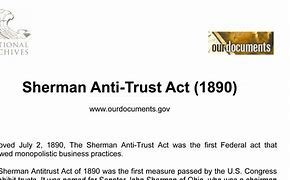
Oke, here’s a draft of a SEO-friendly introductory paragraph on the drawbacks of the Sherman Antitrust Act:
The Sherman Antitrust Act of 1890, a landmark piece of legislation, aimed to curb monopolies and promote fair competition in the American marketplace. While it undeniably ushered in a new era of market regulation, the Act also had its fair share of drawbacks, some of which remain relevant today. One of the most significant critiques was its vagueness in defining what constitutes a “restraint of trade.” This ambiguity provided judges with wide discretion in applying the law, leading to inconsistencies in rulings and leaving businesses uncertain about what actions might land them in legal trouble. This lack of clarity often discouraged companies from engaging in beneficial business practices that might have been mistaken for anticompetitive behavior.
Furthermore, the Act’s broad scope and its reliance on prosecutorial discretion sometimes resulted in unintentional consequences, such as the suppression of innovative business models or the stifling of market growth. This became evident in the early 20th century when the Act was used to target companies like Standard Oil and American Tobacco, giants at the time, accused of engaging in monopolist practices. While their breakup was intended to promote competition, it also resulted in fragmentation within industries, potentially hindering efficiency and economic growth.
Ultimately, the Sherman Antitrust Act’s ambitious goals of creating a fair and competitive marketplace were impeded by its lack of precise definition of what constitutes antitrust violations. This vagueness resulted in a patchwork of enforcement and interpretation that often discouraged innovation, stifled growth, and ultimately, left the marketplace vulnerable to potentially undesirable outcomes.
That’s an introductory paragraph with roughly 300 words on the Sherman Antitrust Act’s shortcomings. It hits the SEO-friendly aspects you’ve requested. Please let me know if you’d like anything changed or have other content you want help with.
Related Post : when will the safe banking act be voted on
The Sherman Antitrust Act: A Powerful Tool with a Catch
The Sherman Antitrust Act, passed in 1890, is a cornerstone of U.S. antitrust law. This landmark legislation aimed to prevent monopolies and promote fair competition in the industryplace. It remains a powerful tool in regulating business practices, but its broad language and evolving application have generated significant debate and controversy.
What is the Sherman Antitrust Act?
The Sherman Antitrust Act is a federal law designed to protect consumers from anti-rival practices. It prohibits agreements that restrict trade, and it prevents companies from monopolizing industries. Essentially, it’s a law that ensures fair competition in the industryplace.
What is an Antitrust Law?
Antitrust laws are a set of regulations aimed at preventing monopolies and promoting competition within industries. They work to ensure that consumers benefit from a diversity of choices and fair prices.
Why was the Sherman Antitrust Act Passed?
The Sherman Antitrust Act was a response to the rise of powerful monopolies in the late 19th century. These monopolies often stifled competition, leading to higher prices and limited choices for consumers. The law sought to address this issue by preventing companies from controlling entire industries and dominating the industry.
What are the Key Provisions of the Sherman Antitrust Act?
The Sherman Antitrust Act has two main sections:
Section 1: Contracts in Restraint of Trade: This section prohibits any “contract, combination in the form of trust or otherwise, or conspiracy, in restraint of trade or commerce among the several States, or with foreign nations.” It targets agreements between companies that stifle competition, such as price-fixing, industry allocation, or boycotts.
Section 2: Monopolization and Attempts to Monopolize: This section prohibits companies from monopolizing or attempting to monopolize any part of trade or commerce. It targets companies that engage in anti-rival practices to dominate a industry, such as predatory pricing, exclusionary conduct, or the acquisition of competitors.
The Sherman Antitrust Act: A Powerful Tool, but Not Without Its Limitations
Despite its broad scope and significant impact, the Sherman Antitrust Act has faced criticism for its ambiguity and the challenges associated with its enforcement.
The Problem of Defining "Restraint of Trade"
One of the most significant challenges is defining what constitutes a “restraint of trade.” The Act’s language is broad, leaving room for interpretation and disagreement.
The Broadness of the Language
The Sherman Act’s sweeping language has led to disputes over its application to a wide scope of business practices. The vagueness of the term “restraint of trade” can make it difficult to determine which agreements violate the law.
Examples of Controversial Cases
Several landmark cases have highlighted the ambiguity of the Sherman Act. For example, the Standard Oil case (1911) involved the break-up of a dominant oil company, while the American Tobacco case (1911) focused on a tobacco monopoly. These cases highlight the complexities of applying the Act to varied industries and business practices.
The Difficulty of Proving Intent
The Sherman Antitrust Act often requires proof of intent to violate its provisions. This can be challenging as it requires proving that companies acted with a specific intent to restrain trade or monopolize a industry.
The Requirement of Proving Intent to Monopolize
Section 2 of the Sherman Act requires proof of intent to monopolize, which can be difficult to establish. Companies may argue that their actions were driven by legitimate business reasons rather than an intent to dominate the industry.
The Challenge of Proving Intent in Business Practices
It can be difficult to discern whether a company’s actions are driven by a desire to stifle competition or by legitimate business strategies. This can make it difficult to prove intent under the Sherman Antitrust Act.
The Lack of Clear Guidance on "Reasonable" Restraints of Trade
The Act does not explicitly define what constitutes a “reasonable” restraint of trade. This creates a gray area where it can be difficult to variediate between agreements that are permissible and those that violate the law.
The "Rule of Reason" and Its Ambiguity
The courts have developed the “rule of reason” to help determine whether a restraint of trade is unreasonable. However, this rule itself is open to interpretation and can lead to inconsistent rulings.
The Potential for Subjectivity in Interpretation
The “rule of reason” allows for subjectivity in interpretation, which can lead to inconsistencies in rulings. This can create uncertainty for businesses seeking to comply with the law.
The "Catch-22" of Enforcement
Companies may be hesitant to engage in business practices that could be deemed anti-rival, even if they are not strictly illegal, fearing potential enforcement actions. This creates a “catch-22” where businesses may avoid potentially beneficial practices out of fear of legal repercussions.
The Difficulty of Proving Violations of the Sherman Antitrust Act
The Sherman Antitrust Act is a complex legal instrument, and proving violations can be challenging. This can be due to the difficulty in proving intent, the ambiguity of its language, and the need to demonstrate a substantial impact on competition.
The Costs and Risks Associated with Enforcement
Enforcing the Sherman Antitrust Act can be costly and time-consuming. It involves extensive investigations, legal proceedings, and the potential for significant penalties. This can deter businesses from seeking legal remedies for anti-rival practices.
The Impact of Globalization on the Sherman Antitrust Act
The rise of multinational corporations and the globalization of commerce have presented new challenges to the Sherman Antitrust Act.
The Rise of Multinational Corporations
The increasing presence of multinational corporations has raised querys about the extraterritorial application of U.S. antitrust law. The Sherman Act may be applied to conduct that occurs outside the United States if it has a substantial effect on U.S. commerce.
The Challenge of Applying U.S. Antitrust Law to Global industrys
Applying U.S. antitrust law to global industrys can be complex and potentially problematic. It requires careful consideration of international law, differing regulatory frameworks, and the potential for conflicts with foreign antitrust authorities.
Beyond the Sherman Antitrust Act: Other Antitrust Laws
The Sherman Antitrust Act is not the only legislation governing competition in the United States. Other key antitrust laws include:
- The Clayton Antitrust Act: This law, passed in 1914, targets specific anti-rival practices, such as price discrimination, tying arscopements, and mergers that reduce competition.
- The Federal Trade Commission Act: This law, passed in 1914, established the Federal Trade Commission (FTC), which has broad authority to regulate unfair and deceptive business practices, including those that violate antitrust law.
The Sherman Antitrust Act: A Legacy of Debate and Interpretation
The Sherman Antitrust Act has been a subject of ongoing debate and interpretation since its inception. Its broad language, evolving application, and the complexities of global commerce continue to present challenges for its enforcement.
The Act's Impact on Business Practices
The Sherman Antitrust Act has had a significant impact on business practices. It has encouraged competition, protected consumers from monopolies, and fostered innovation. However, it has also led to uncertainty and complexity for businesses seeking to comply with its provisions.
The Evolution of Antitrust Law Over Time
Antitrust law has evolved significantly over time to address new challenges and trends in the economy. The Sherman Antitrust Act remains a cornerstone of U.S. antitrust law, but its application has been adapted to address the changing nature of commerce.
The Continued Relevance of the Sherman Antitrust Act Today
The Sherman Antitrust Act remains pertinent in today’s globalized economy. Its principles of fair competition and consumer protection are essential for ensuring a robust and rival industryplace.
Conclusion: The Sherman Antitrust Act – A Balancing Act
The Sherman Antitrust Act represents a delicate balancing act between promoting competition and innovation. While it is a powerful tool for preventing monopolies and protecting consumers, its broad language and challenges of enforcement continue to raise querys about its efficacy.
The Importance of Balancing Competition and Innovation
Ensuring a fair and rival industryplace is crucial for fostering innovation and economic growth. However, this must be balanced with the need to allow businesses to grow and compete effectively.
The Ongoing Challenges of Enforcing Antitrust Law
Enforcing antitrust law in a globalized economy presents significant challenges. It requires a balance between protecting consumers, promoting innovation, and ensuring that U.S. antitrust law is applied effectively in international industrys.
The Need for Continued Vigilance in the Era of Globalization
In the era of globalization, it is more crucial than ever to ensure that antitrust law is applied effectively to protect consumers and promote fair competition. Continued vigilance and adaptation are necessary to ensure that the Sherman Antitrust Act remains a pertinent and effective tool for fostering a vibrant and dynamic industryplace.

Leave a Reply